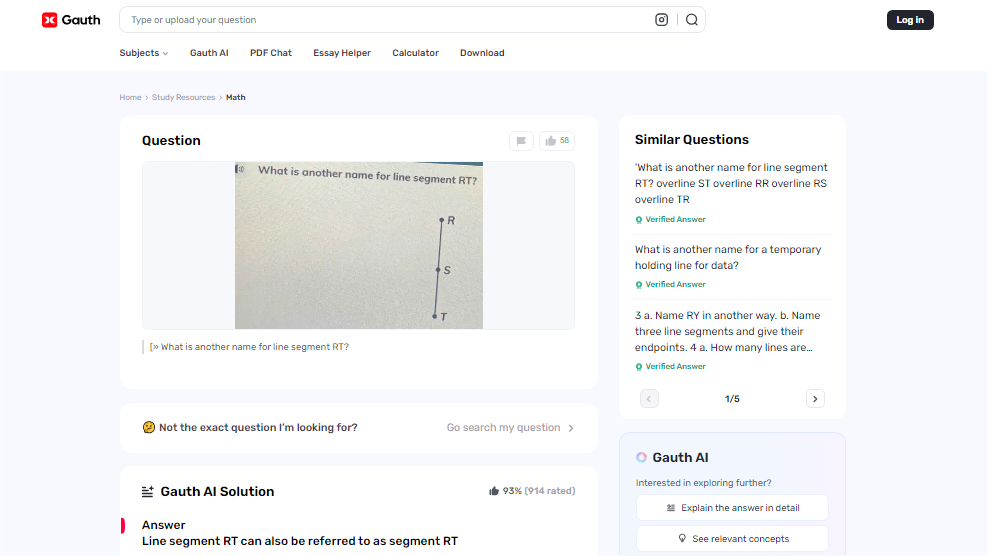Especially in today’s world of mathematics and engineering, it becomes imperative to solve geometrical problems not only accurately but also quickly. It is in this context that Gauth AI stands as a promising solution for performing complex geometric calculations and analyses. This article discusses how Gauth AI uses artificial intelligence to answer geometrical questions instantly instead of taking hours to provide solutions to geometrical problems.
Introduction
Gauth AI is a complete and novel approach to solving geometrical problems. AI becomes a solution that is not only correct in its calculations but also provides them immediately. This capability is especially useful for disciplines that require high levels of accuracy and productivity, including architecture, engineering, and robotics. This raises the need for tools such as Gauth AI as a way of improving productivity and reducing the time taken to produce geometric solutions.
Understanding Geometrical Concepts
Geometry is the basis of many scientific and engineering disciplines as it offers patterns for grasping configuration and formations. Basic principles like lines, angles and shapes are very useful when solving geometrical problems. Whether measuring the length of a building or determining the path taken by a robotic arm, accurate geometric computation remains crucial for getting the right results.
Difficulties Experienced in the Solving of Geometrical Problems
This is because traditional techniques for solving geometric problems involve computations that take time and can produce erroneous results. Geometry adds to the confusion through the configuration and design of the pieces, which makes the process more delicate. Gauth AI tackles these issues by automating the calculation process and using advanced algorithms and machine learning to make it accurate.
Introducing Gauth AI
Gauth AI distinguishes itself as a sophisticated solution aimed solely at solving geometric problems. It uses advanced artificial intelligence techniques to understand and analyze geometric information and can provide solutions quickly. Due to its natural language processing and image recognition features, Gauth AI can recognize a wide range of geometric problems and perform simple calculations and spatial reasoning.
Key Features of Gauth AI
Some of the more noticeable characteristics of utilizing Gauth AI include instant calculation of angles, lengths and other geometric parameters. Complex geometric shapes outperform other geometries by providing detailed analysis and graphics that help comprehend geometric concepts. This capability makes Gauth AI invaluable in learning environments as it expounds on ideas and gives a clear and structured approach to solving problems.
Applications in Real-World Scenarios
The practical uses of Gauth AI transcend almost all sectors of the economy. It also helps in the design of structures, especially in architecture, where spatial planning and construction are made much easier through the use of BIM. Engineers use Gauth AI to model and predict mechanical systems, while roboticists use it to control movements according to geometric specifications. They not only optimize the work process but also advance knowledge in their spheres of application.
Relative Advantages Over Traditional Techniques
Relative to conventional manual solutions, Gauth AI has several benefits. They save much time in solving geometric problems; as a result, specialists are free to perform more intricate operations. Reduced errors and increased efficiency have been achieved in the case studies, which depict the effectiveness of applying Gauth AI in improving geometric analysis.
Applying Gauth AI For Solving Geometrical Problems
• Enter the Problem: Use Gauth AI to input geometrical problems in plain text or an image. Images can be uploaded directly from the device by dragging them into the platform or clicking ‘upload’ to browse for the image.
• Processing Insight: Gauth AI uses NLP and machine learning to analyze your inputs and break them down into geometric components such as lines, angles, and shapes.
• Comprehensive Analysis: Get a clear response with written paraphrases, additional clarifications, and symbolic representation of your queries to ensure you have a deeper and enhanced understanding of geometrical concepts.
Geometrical Problem Example Through Gauth AI
Question
You can see the question “what is another name for line segment rt” in the following image. You can put questions like this or more to get a comprehensive answer:
Gauth AI Answer
Line segment RT can also be referred to as segment RT
Explanation
To determine another name for a line segment, we need to consider the context in which the segment is being used. However, without additional context or a diagram, we can only provide a general description of a line segment.

Step 1
Learn what is meant by the term line segment. A line segment is a kind of line that has two points and contains every moment of the line between these two points.
Step 2
Consider the context or common terminologies. In geometry, line segments can be referred to based on their position or role in various figures, such as a side of a triangle or polygon, a radius or chord in a circle, etc.
Step 3
Since no specific context is given, we can only refer to line segment RT by its endpoints, which is the standard naming convention for line segments.
Conclusion
In summary, Gauth AI is a revolutionary advancement in the field of geometrical problem-solving. This makes it useful in mathematics, engineering, and other applications since it provides accurate and real-time solutions. With such developments in AI in the future, the application of tools like Gauth AI in mathematical applications will also expand for further potential enhancement. The adoption of AI solutions like Gauth AI is, therefore, the way forward in opening new frontiers for geometric analysis and problem-solving. Through the use of artificial intelligence, the world can advance scientific research, enhance technological advancement, and in effect, fashion a more efficient and knowledgeable society.


